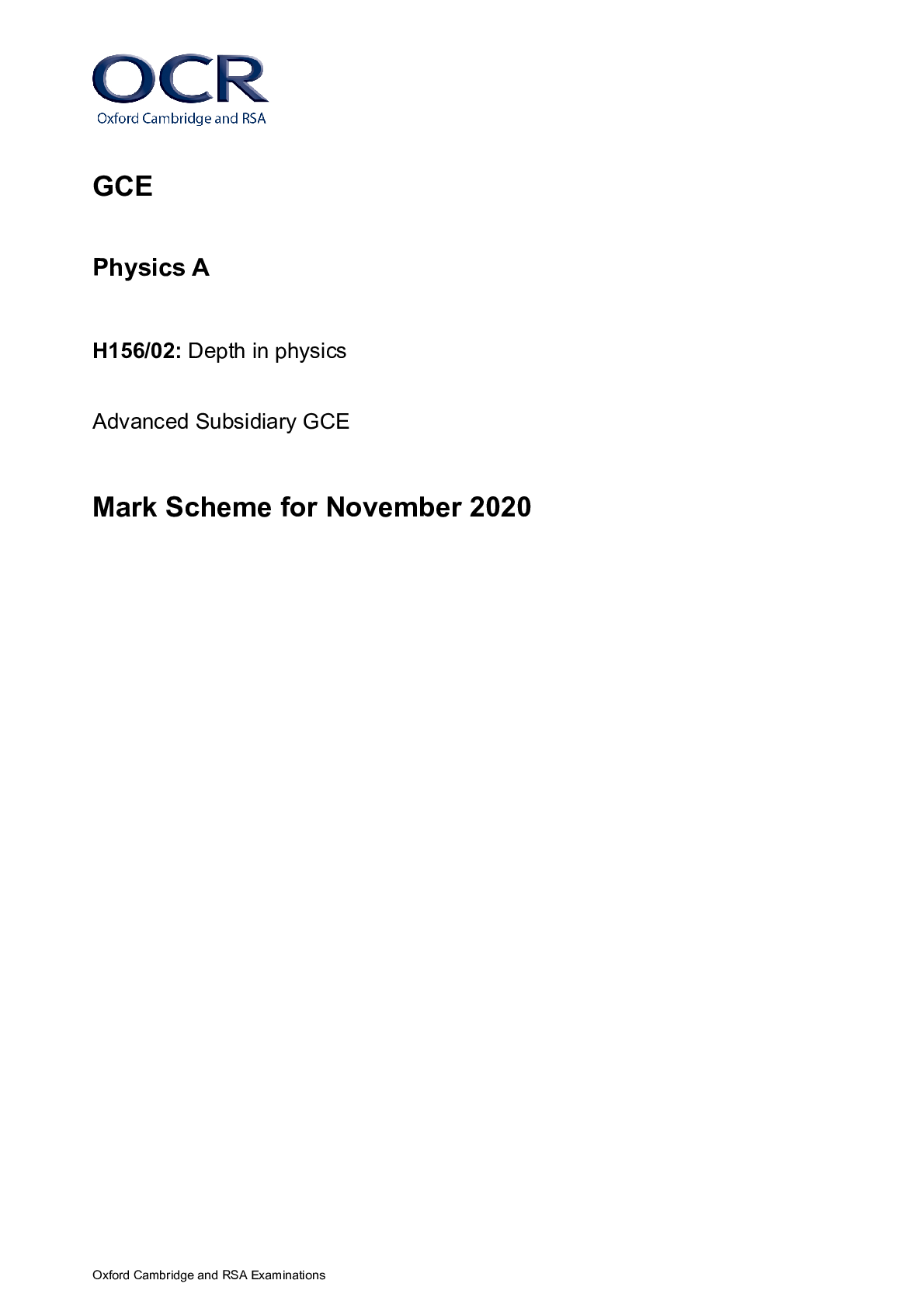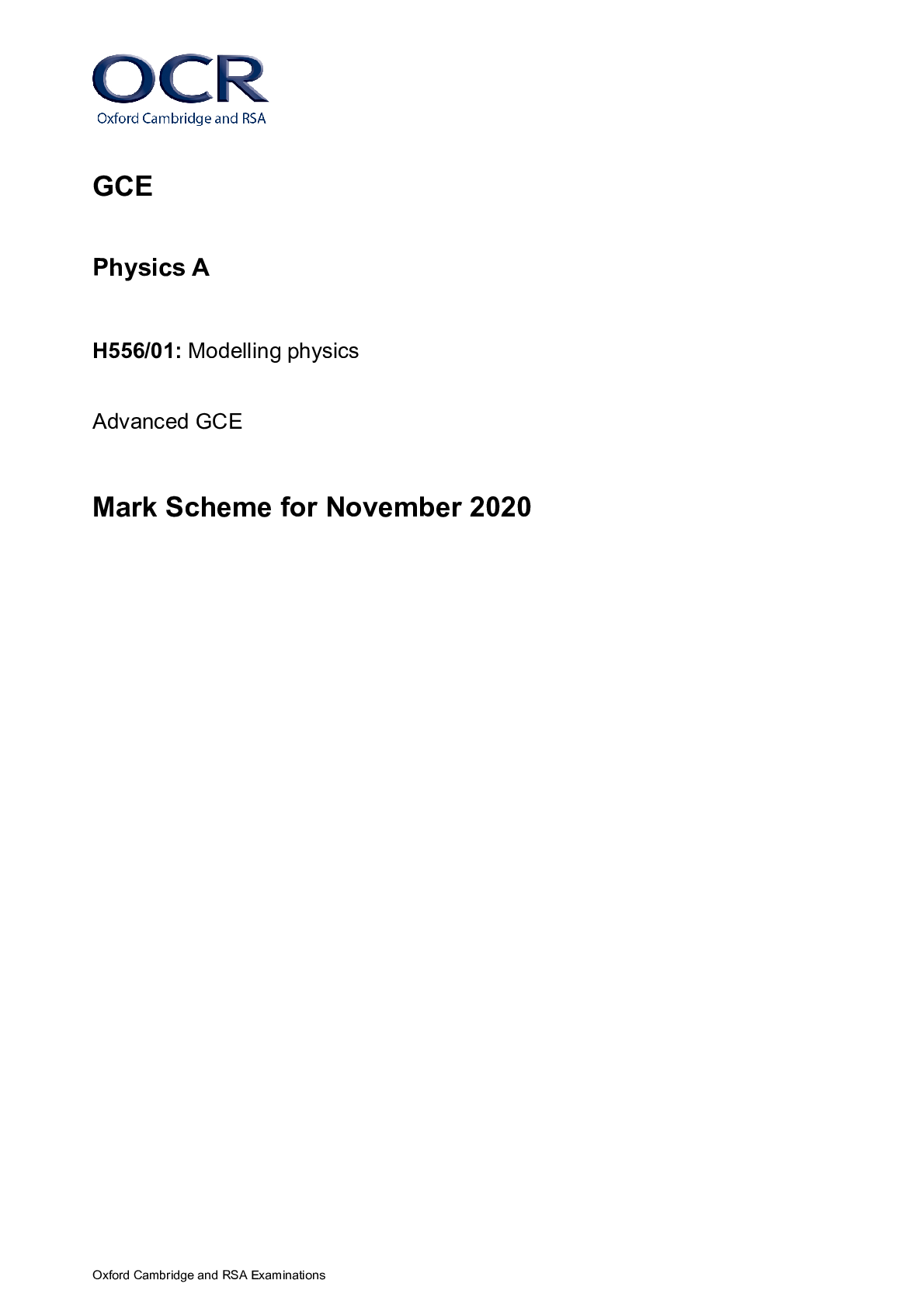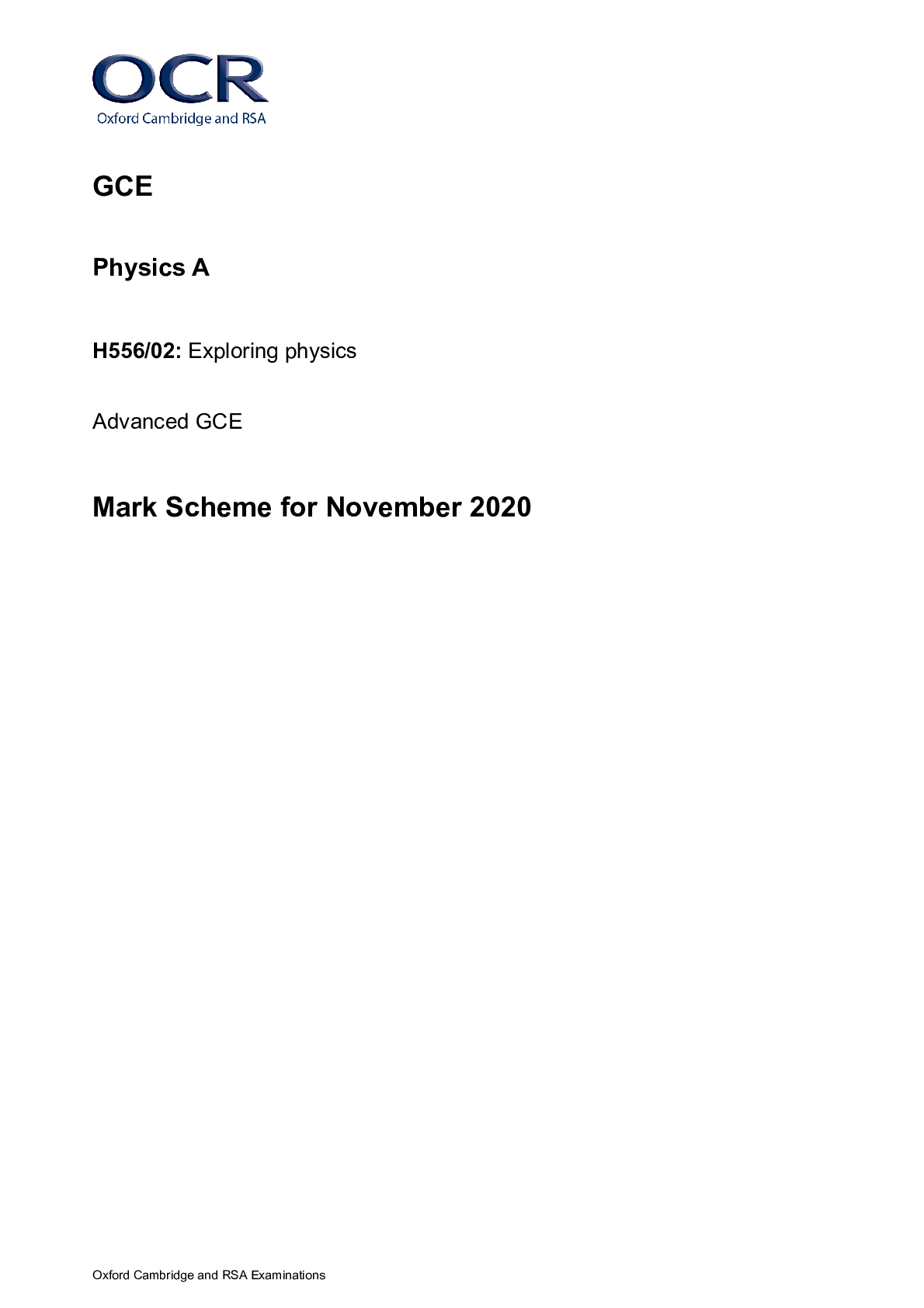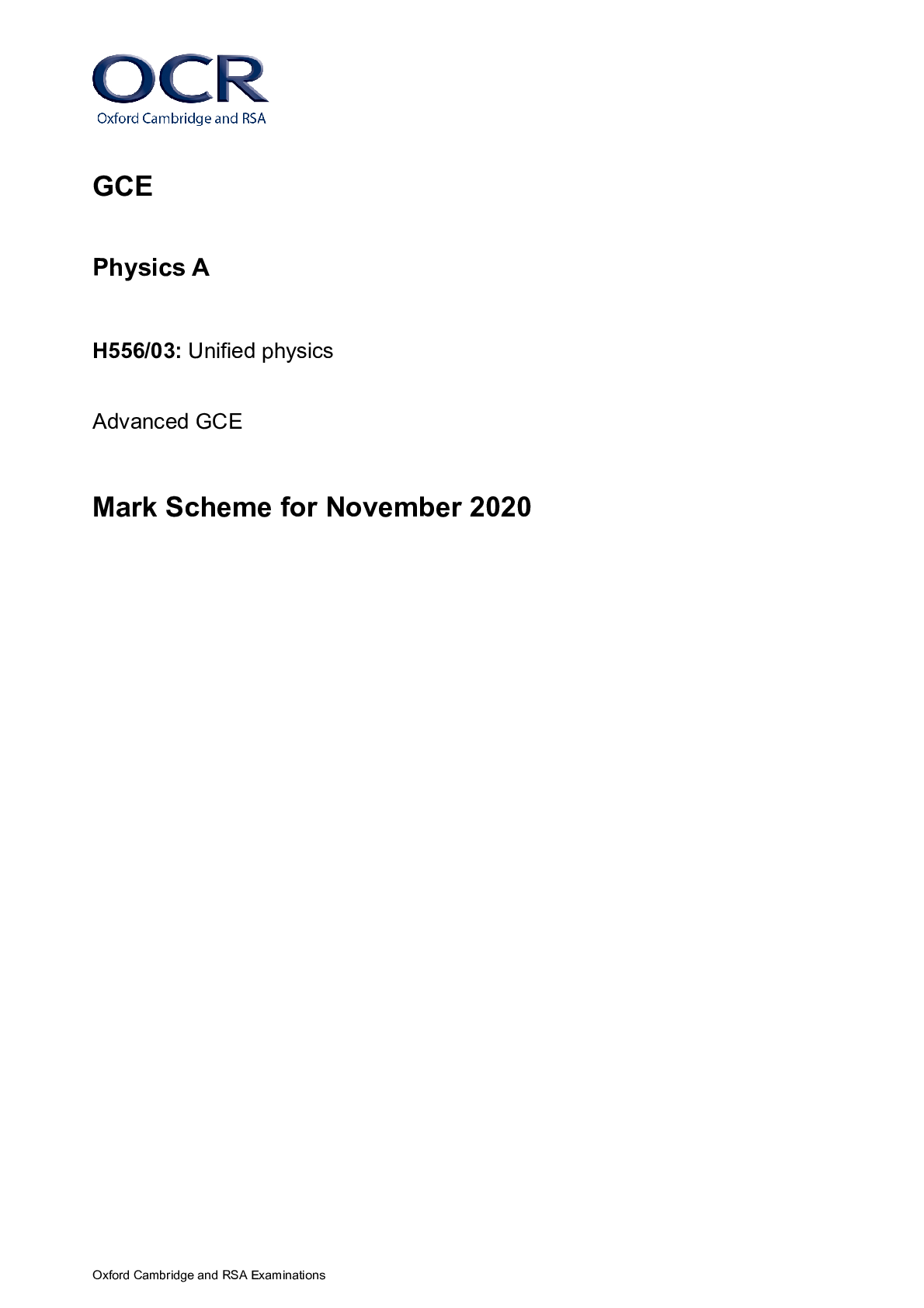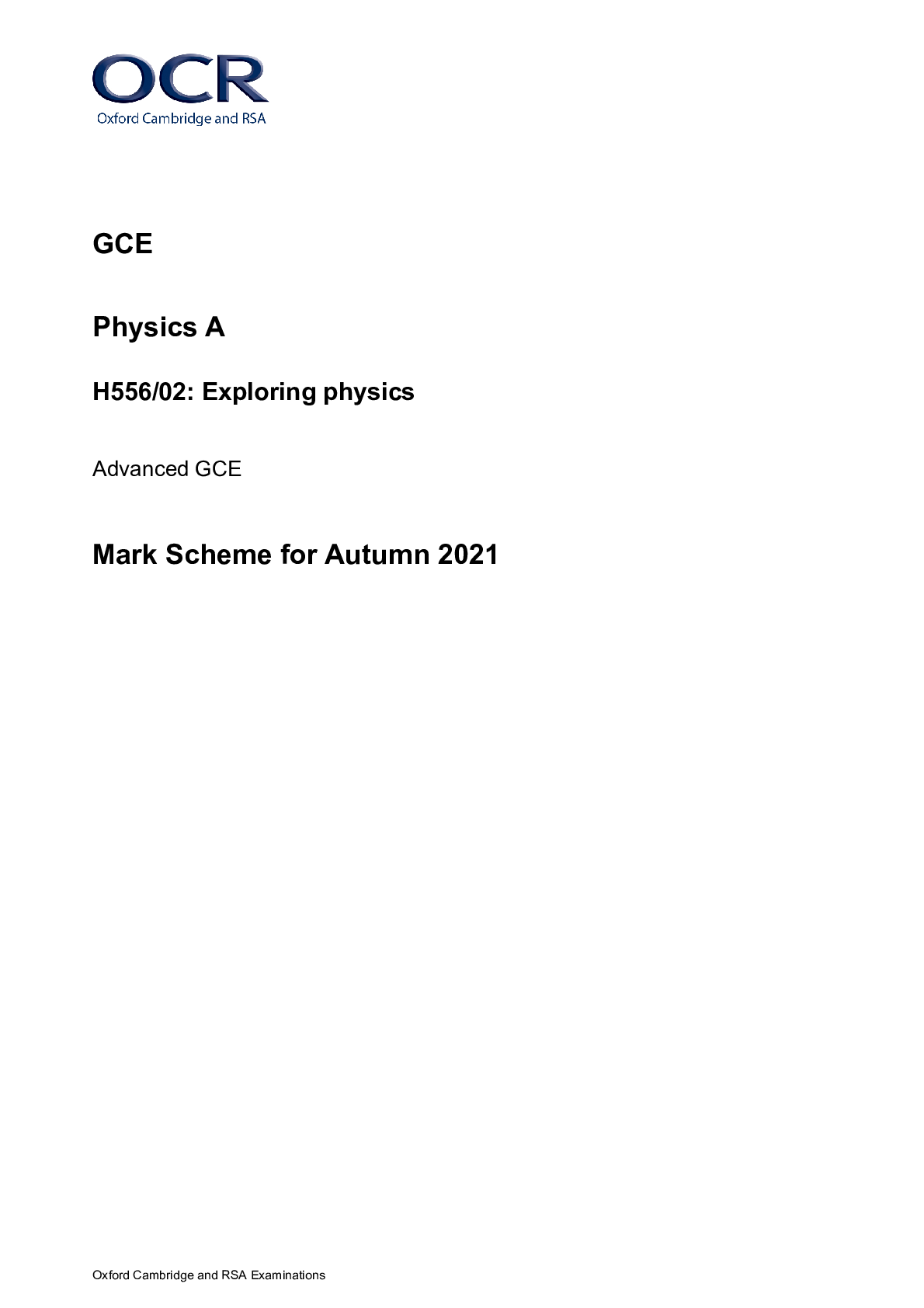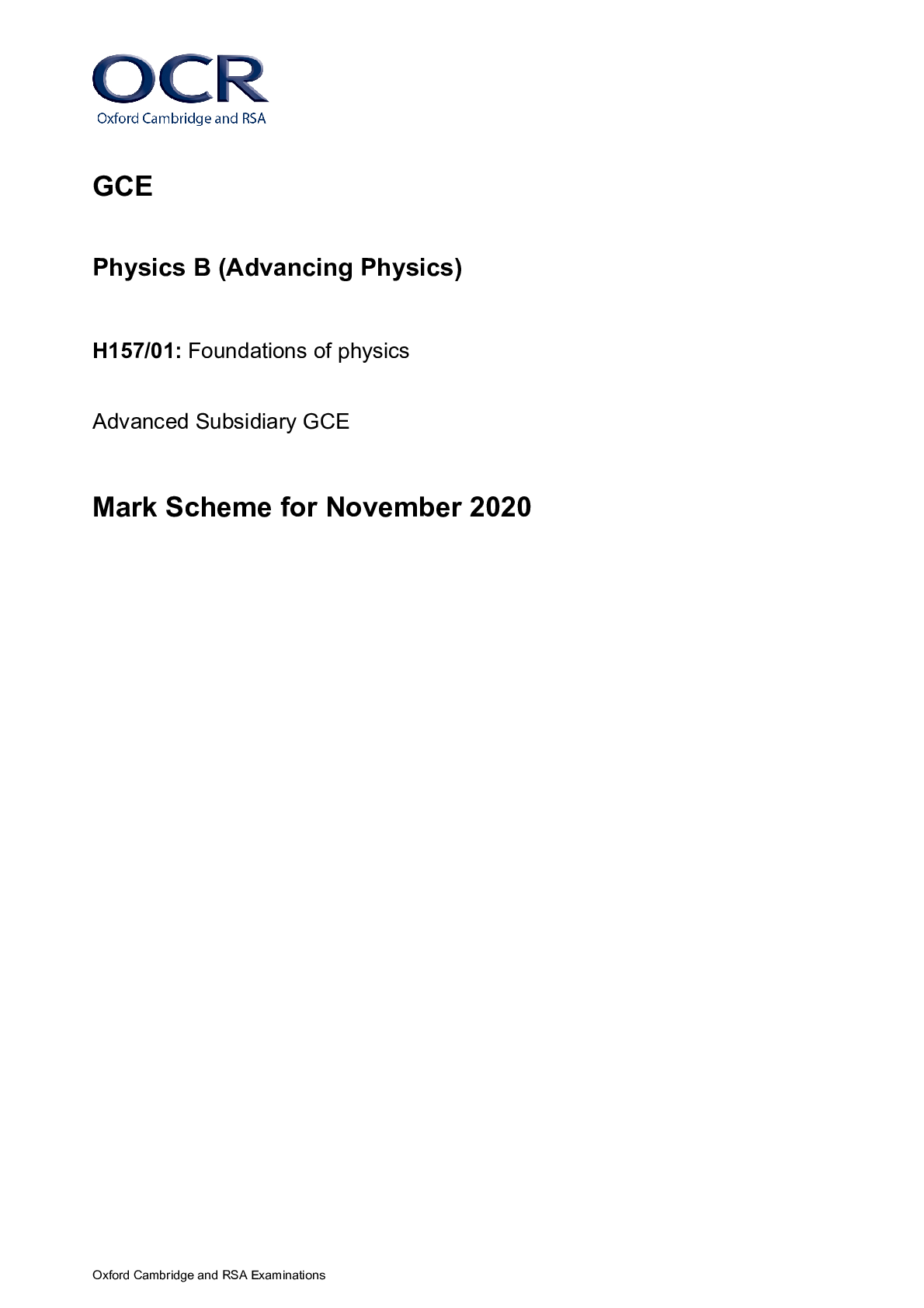History > AS Mark Scheme > GCE History A Y102/01: Anglo-Saxon England and the Norman Conquest 1035-1107 Advanced GCE Mark Schem (All)
GCE History A Y102/01: Anglo-Saxon England and the Norman Conquest 1035-1107 Advanced GCE Mark Scheme for November 2020
Document Content and Description Below
Oxford Cambridge and RSA Examinations GCE History A Y102/01: Anglo-Saxon England and the Norman Conquest 1035-1107 Advanced GCE Mark Scheme for November 2020Oxford Cambridge and RSA Examinations ... OCR (Oxford Cambridge and RSA) is a leading UK awarding body, providing a wide range of qualifications to meet the needs of candidates of all ages and abilities. OCR qualifications include AS/A Levels, Diplomas, GCSEs, Cambridge Nationals, Cambridge Technicals, Functional Skills, Key Skills, Entry Level qualifications, NVQs and vocational qualifications in areas such as IT, business, languages, teaching/training, administration and secretarial skills. It is also responsible for developing new specifications to meet national requirements and the needs of students and teachers. OCR is a not-for-profit organisation; any surplus made is invested back into the establishment to help towards the development of qualifications and support, which keep pace with the changing needs of today’s society. This mark scheme is published as an aid to teachers and students, to indicate the requirements of the examination. It shows the basis on which marks were awarded by examiners. It does not indicate the details of the discussions which took place at an examiners’ meeting before marking commenced. All examiners are instructed that alternative correct answers and unexpected approaches in candidates’ scripts must be given marks that fairly reflect the relevant knowledge and skills demonstrated. Mark schemes should be read in conjunction with the published question papers and the report on the examination. © OCR 2020Y102/01 Mark Scheme November 2020 2 Annotations Annotation Meaning of annotation Blank Page Highlight Off-page comment Assertion Analysis Evaluation Explanation Factor Illustrates/Describes Irrelevant, a significant amount of material that does not answer the question Judgement Knowledge and understanding Provenance Simple comment Unclear ViewY102/01 Mark Scheme November 2020 3 Subject Specific Marking Instructions MARK SCHEME Section A Question Answer Mark Guidance 1 Using these four sources in their historical context, assess how far they support the view that the rebellion of 1088 was a serious threat to William II. • In discussing how Source A supports the view, candidates might refer to the fact that the higher nobility, that is the people with power, were all against William and their lands covered a wide geographical range. • In discussing the provenance of Source A, answers might comment that Henry of Huntingdon was hostile to the rebels and so would not exaggerate their level of support. • In discussing the historical context of Source A, answers might refer to the fact that the nobles who owned land in both England and Normandy were attempting to secure a single ruler to both countries so that their loyalties (and thus their hold on their lands) would not be divided. • In discussing how Source B supports the view, candidates might refer to the threat posed by Robert of Normandy, especially if he acted swiftly, given the extent of support he had from the Norman nobility. • In discussing the provenance of Source B, answers might comment that the chronicler was using a collection of sources and writing a little after the event. As with Source A he is unlikely to give more credence to the rebels than he needs to. • In discussing the historical context of Source B, answers might argue that the Norman Conquest of 30 • No set answer is expected. • At Level 5 there will be judgement about the issue in the question. • To be valid judgements they must be supported by accurate and relevant material. • At Level 4 and below, answers may be simply a list of which sources support or challenge the view in the question. • Knowledge must not be credited in isolation, it should only be credited where it is used to analyse and evaluate the sources, in line with the descriptions in the levels mark scheme.Y102/01 Mark Scheme November 2020 4 1066 had begun with an invasion at the start of Harold’s reign, so Robert could be equally successful. • In discussing how Source C does not support the view, candidates might refer to the support which the English were ready to give William. • In discussing the provenance of Source C, answers might argue that the monk was an upholder of law and order and disliked rebels. • In discussing the historical context of Source C, answers might refer to the situation where William saw the reality of the threat and acted quickly to defuse it by astutely promising the English good government, as well as silver! • In discussing how Source D does not support the view, candidates might refer to the fact that Robert of Normandy did not come himself at first and his supporters began to surrender as the English provided the promised support to their king. • In discussing the provenance of Source D, answers might comment on the Chronicle highlighting the role of the English. • In discussing the historical context of Source D, answers might refer to the exiling of Odo and the eventual agreement with Robert of Normandy which secured William II’s position.Y102/01 Mark Scheme November 2020 5 2* Section B 'Harold was defeated at Hastings because he was unlucky rather than incompetent.' How far do you agree? In arguing that Harold was unlucky and not incompetent: • Answers might consider that Harold kept watch on the south coast but William landed when Harold went north to deal with Hardrada. • Answers might consider that changes in the weather allowed William to sail to England after Harold had been forced to redirect his forces north. • Answers might consider that the weariness of Harold’s troops meant that some of the key men like the archers were not at Hastings. • Answers might suggest that Harold came up against a powerful leader whose generalship was better than his and who had the support of the Church. • Answers might argue that Harold’s troops fought bravely all day and his housecarls defended him to the end, so he was not an incompetent leader. • Answers might refer to Harold’s death which ensured the victory went to William. In arguing that Harold was incompetent: • Answers might suggest that the decision to march south quickly after Stamford Bridge was a poor one. • Answers might consider that Harold did not need to fight William so rapidly and should have waited for all his troops to join him. • Answers might consider that Harold was unable to keep discipline among his troops and so they gave up their position on the hill to pursue the Normans. 20 • No set answer is expected. • At higher levels, candidates will focus on weighing up luck and incompetence; but at Level 4, may simply list the reasons for Harold’s defeat. • At Level 5 and above there will be judgement as to the relative importance of luck and incompetence. • At higher levels candidates might establish criteria against which to judge the factors. • To be valid judgements, claims must be supported by relevant and accurate material. If not, they are assertions. • Knowledge must not be credited in isolation, it should only be credited where it is used as the basis for analysis and evaluation, in line with the descriptions in the levels mark scheme.Y102/01 Mark Scheme November 2020 6 3* How far was William I challenged more by external than internal threats as king of England after 1066? In assessing the external threats, • Answers might consider that invasions from Scandinavian claimants took place in 1069, when York was sacked, in 1075 and in 1085 so the threat continued throughout the reign. • Answers might consider that Scotland was hostile, and Malcolm sheltered Edgar the Atheling who had a claim to the throne and was in touch with the French king, increasing the threat. • Answers might argue that William came to terms with the Scots for a time, although the peace did not last. • Answers might argue that William made peace with the French to lessen the possibility of his enemies uniting against him. • Answers may suggest that, nevertheless, William’s internal and external enemies did join together at times. In assessing the internal threats, • Answers might refer to opposition in Exeter in 1067, invasions from Harold’s sons and later the rebellion in the fens, attacks on Norman lords and the risings led by Edwin and Morcar. • Answers might consider that William defeated all these and, after some initial leniency, exacted revenge in the ‘harrying of the north’ which discouraged further threats to his power. • Answers might suggest that William felt secure enough to be absent in Normandy frequently, leaving regents to rule England. 20 • No set answer is expected. • At higher levels, candidates will focus on weighing up the threats: but at level 4, may simply list threats. • At Level 5 and above there will be judgement as to which was the greater threat. • At higher Levels candidates might establish criteria against which to judge the extent or degree of the threats. • To be valid judgements, claims must be supported by relevant and accurate material. If not, they are assertions. • Knowledge must not be credited in isolation, it should only be credited where it is used as the basis for analysis and evaluation, in line with descriptions in the levels mark scheme.Y102/01 Mark Scheme November 2020 7 • Answers might consider that the rising of the earls of Hereford and Norfolk in 1074-5 was a threat, but their plot was betrayed and defeated when William was in Normandy, so it was a minor threat.Y102/01 Mark Scheme November 2020 8 APPENDIX 1 – this contains a generic mark scheme grid AO2: Analyse and evaluate appropriate source materials, primary and/or contemporary to the period, within its historical context. Generic mark scheme for Section A, Question 1: How far do the four sources support the view? [30] Level 6 26–30 marks The answer has a very good focus on the question throughout. The sources are fully evaluated, using both provenance and detailed and accurate knowledge of their historical context in a balanced way, in order to engage with the sources and reach a convincing, fully supported analysis of them in relation to the issue in the question. Level 5 21–25 marks The answer has a good focus on the question. The sources are evaluated, using both provenance and relevant knowledge of their historical context, in order to engage with the sources and reach a supported analysis of them in relation to the issue in the question. There may be some imbalance in the analysis between use of provenance and use of knowledge. Level 4 16–20 marks The answer is mostly focused on the question. The sources are evaluated, using both provenance and generally relevant knowledge of their historical context, in order to engage with the sources and produce an analysis of them in relation to the question. The use of provenance may not be developed. Level 3 11–15 marks The answer is partially focused on the question. There is partial evaluation of the sources, with use of some knowledge of their historical context, in order to engage with the sources and produce a partial analysis of them in relation to the question. Level 2 6–10 marks The answer has only limited focus on the question. Evaluation of the sources is very general. There is limited use of generalised knowledge of historical context to engage with the sources and produce a basic analysis of them in relation to the question. Level 1 1–5 marks This answer is on the wider topic area, but not on the detail of the question. The sources are evaluated in a very basic way, primarily being used as a source of information with understanding of them being only partial. A very generalised knowledge of historical context is used in a very limited way to engage with the sources and to attempt a very simple analysis of them in relation to the question. 0 marks No evidence of understanding or reference to the sources.Y102/01 Mark Scheme November 2020 9 AO1: Demonstrate, organise and communicate knowledge and understanding to analyse and evaluate the key features related to the periods studied, making substantiated judgements and exploring concepts, as relevant, of cause, consequence, change, continuity, similarity, difference and significance. Generic mark scheme for Section B, Questions 2 and 3: Essay[20] Level 6 17–20 marks There is a consistent focus on the question throughout the answer. Accurate and detailed knowledge and understanding is demonstrated throughout the answer and is consistently evaluated and analysed in order to reach substantiated, developed and sustained judgements. There is a well-developed and sustained line of reasoning which is coherent and logically structured. The information presented is entirely relevant and substantiated. Level 5 13–16 marks There is a mostly consistent focus on the question. Generally accurate and detailed knowledge and understanding is demonstrated through most of the answer and is evaluated and analysed in order to reach substantiated judgements, but these are not consistently well-developed. There is a well-developed line of reasoning which is clear and logically structured. The information presented is relevant and in the most part substantiated. Level 4 10–12 marks The question is generally addressed. Generally accurate and sometimes detailed knowledge and understanding is demonstrated through most of the answer with evaluation and some analysis, and this is used appropriately to support the judgements that are made. There is a line of reasoning presented with some structure. The information presented is in the most-part relevant and supported by some evidence. Level 3 7–9 marks The question is partially addressed. There is demonstration of some relevant knowledge and understanding, which is evaluated and analysed in parts of the answer, but in places knowledge is imparted rather than being used. The analysis is appropriately linked to the judgements made, though the way in which it supports the judgements may not always be made explicit. The information has some relevance and is presented with limited structure. The information is supported by limited evidence. Level 2 4–6 marks The focus is more on the topic than the specific demands of the question. Knowledge and understanding is limited and not well used, with only limited evaluation and analysis, which is only sometimes linked appropriately to the judgements made. The information has some relevance, but is communicated in an unstructured way. The information is supported by limited evidence and the relationship to the evidence may not be clear. Level 1 1–3 marks The answer relates to the topic but not the specific question. The answer contains only very limited relevant knowledge which is evaluated and analysed in a very limited way. Judgements are unsupported and are not linked to analysis. Relevant knowledge is limited, generalised and poorly used; attempts at argument are no more than assertion. Information presented is basic and may be ambiguous or unstructured. The information is supported by limited evidence. 0 marks No evidence of understanding and no demonstration of any relevant knowledge.Y102/01 Mark Scheme November 2020 10 APPENDIX 2 – this section contains additional subject specific information Use this space if you have extensive subject specific information that is inappropriate to include elsewhere.OCR (Oxford Cambridge and RSA Examinations) The Triangle Building Shaftesbury Road Cambridge CB2 8EA [Show More]
Last updated: 1 year ago
Preview 1 out of 12 pages
Instant download
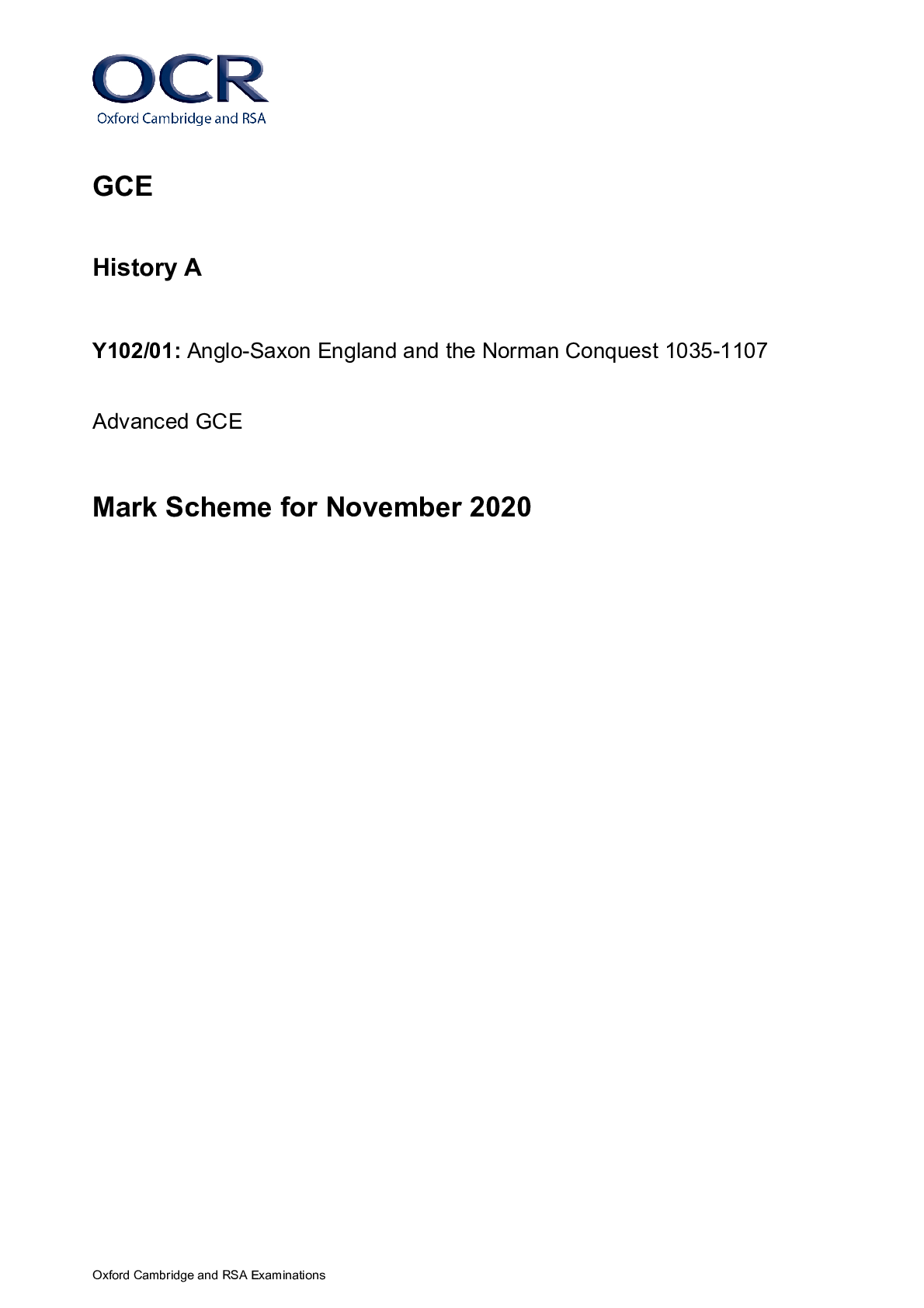
Buy this document to get the full access instantly
Instant Download Access after purchase
Add to cartInstant download
Reviews( 0 )
Document information
Connected school, study & course
About the document
Uploaded On
Oct 10, 2022
Number of pages
12
Written in
Additional information
This document has been written for:
Uploaded
Oct 10, 2022
Downloads
0
Views
39

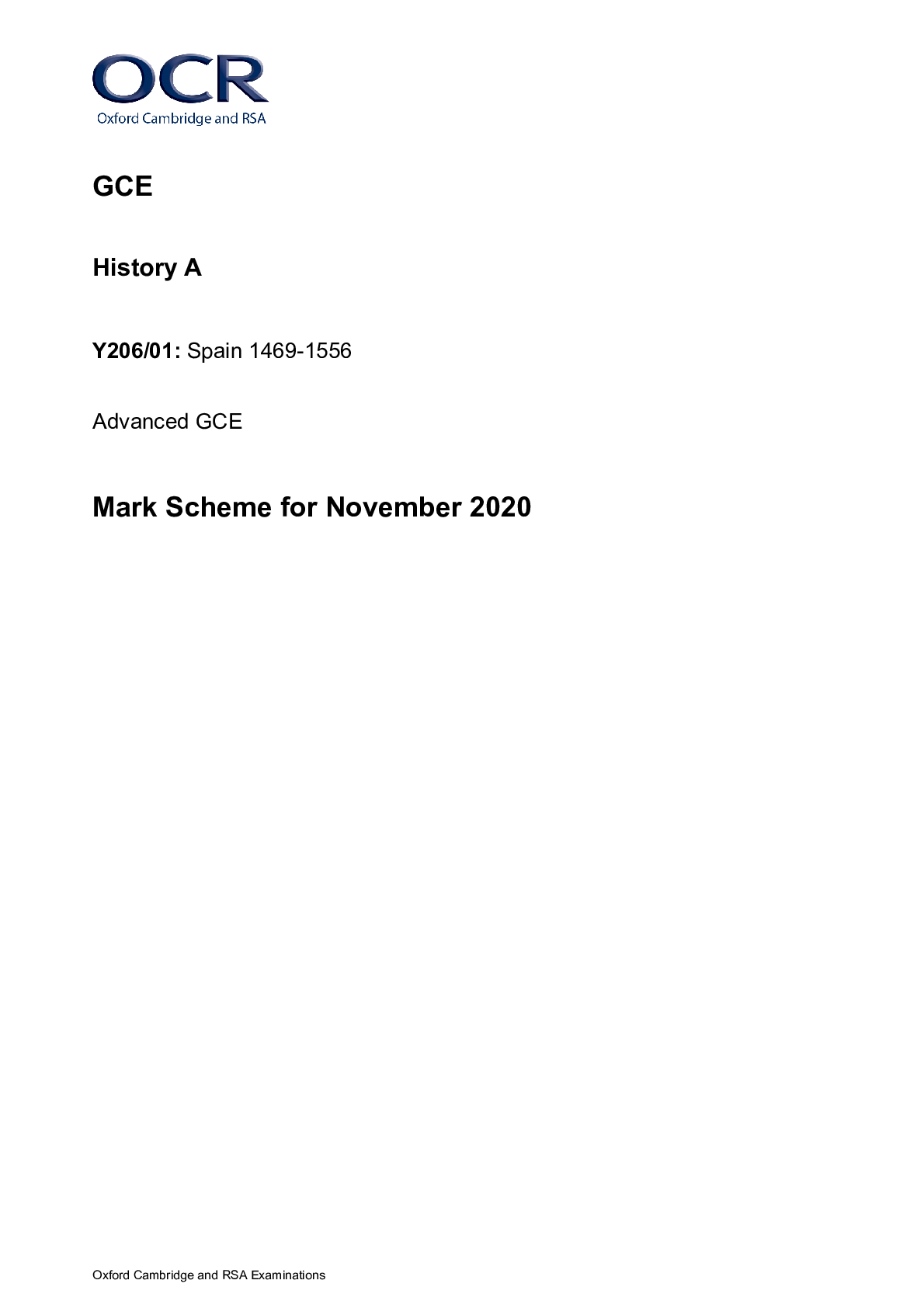
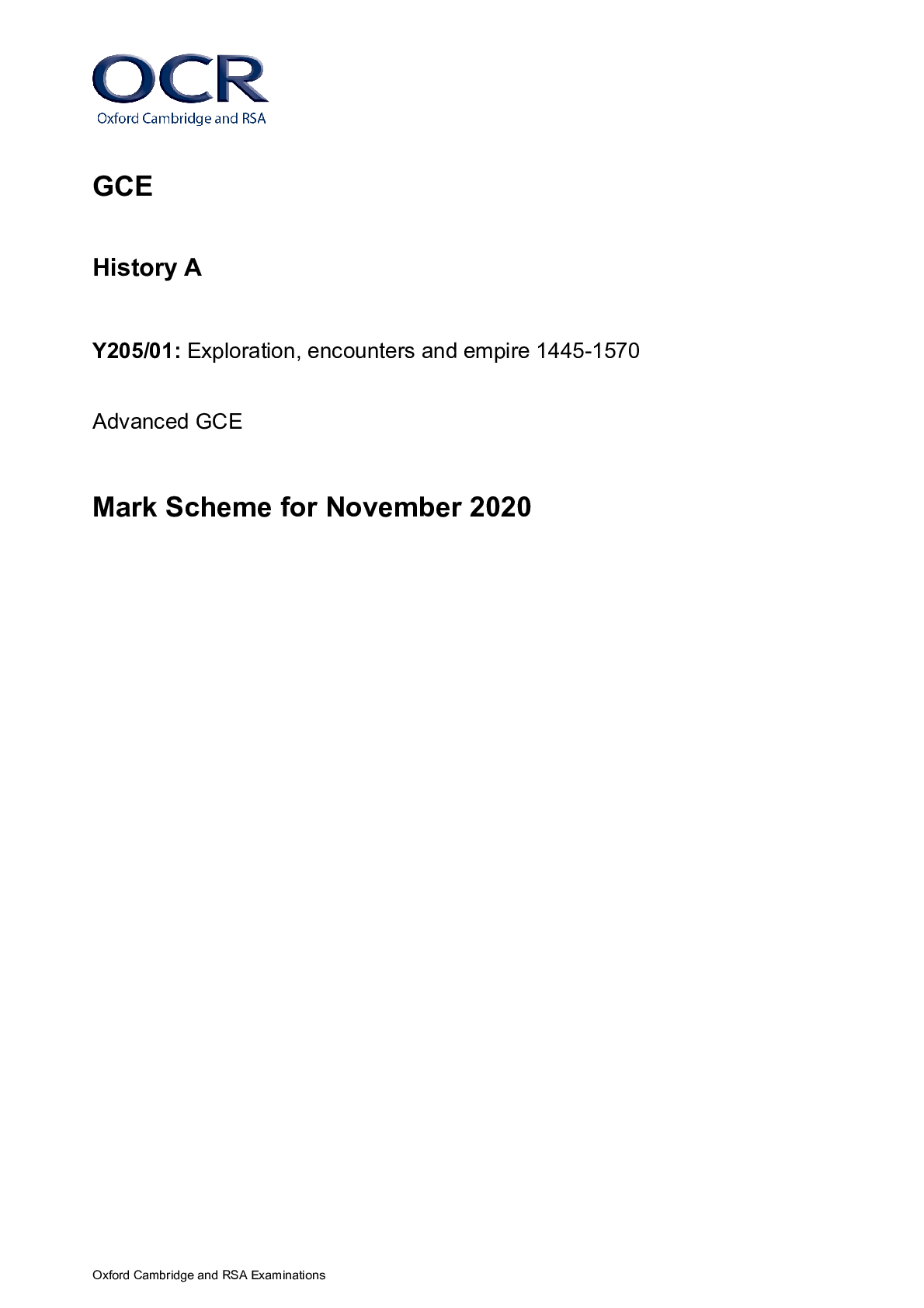






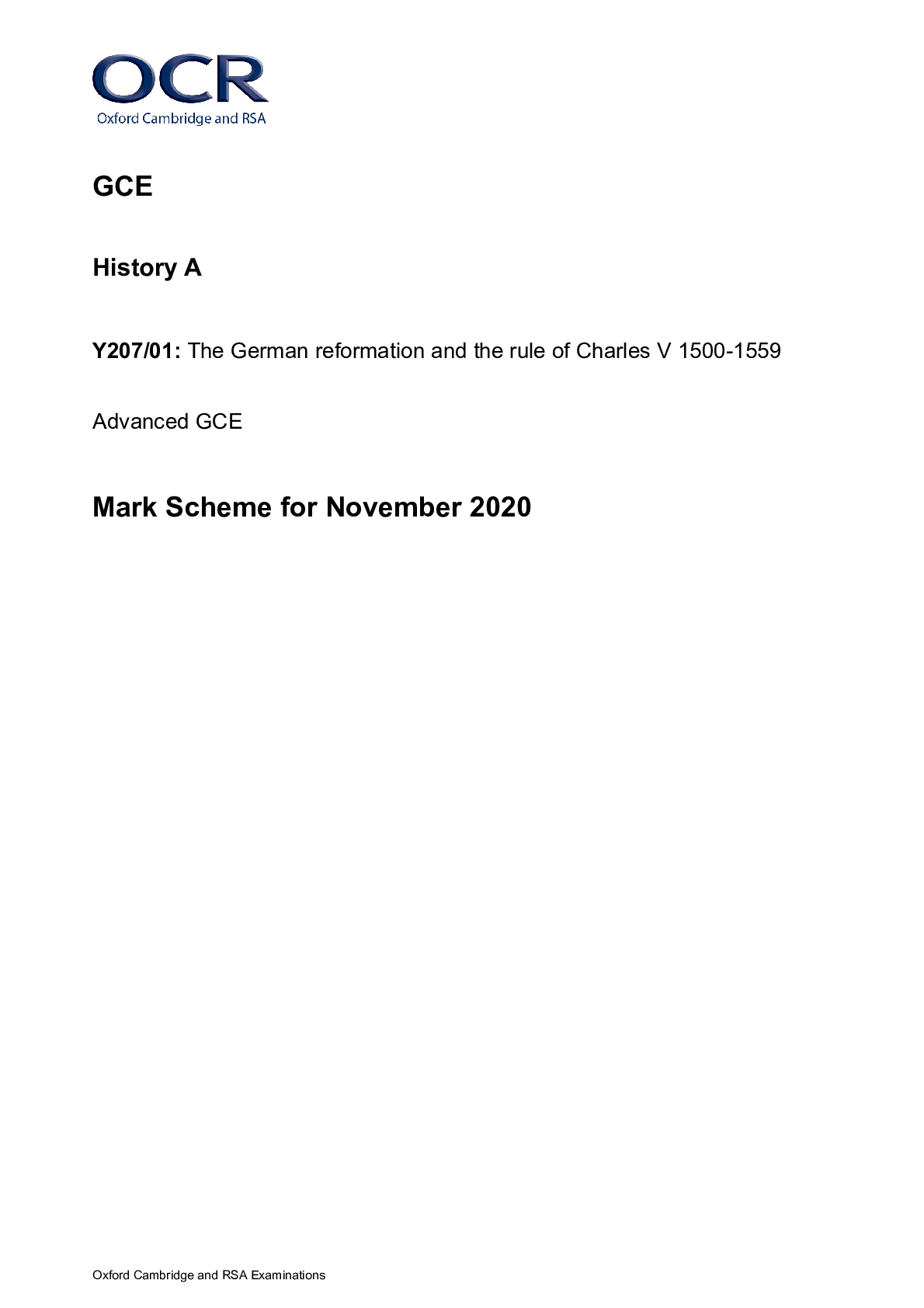





.png)

